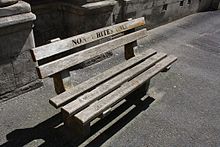Reservation of Separate Amenities Act, 1953
{{Infobox legislation | short_title = Reservation of Separate Amenities Act, 1953 | legislature = | image = Coat of Arms of South Africa (1932-2000).svg | imagesize = | imagealt = | caption = | long_title = Act to provide for the reservation of public premises and vehicles or portions thereof for the exclusive use of persons of a particular race or class, for the interpretation of laws which provide for such reservation, and for matters incidental thereto. | citation = Act No. 49 of 1948 | territorial_extent = | enacted_by = Parliament of South Africa | date_enacted = 9 october 1953 | date_passed = | enacted_by2 = | date_enacted2 = | date_passed2 = | date_assented = | royal_assent = 5 October 1953 | date_signed = | date_commenced = 9 October 1953 | date_of_expiry = | date_repealed = 15 October 1990 | administered_by = | bill = | bill_citation = | bill_date = | introduced_by = | 1st_reading = | 2nd_reading = | 3rd_reading = | conf_committee_passed = | bill2 = | bill_citation2 = | bill_date2 = | introduced_by2 = | 1st_reading2 =
system of racial segregation in South Africa.
The Act legalized the racial segregation of public premises, vehicles and services. Only public roads and streets were excluded from the Act. The Section 3b of the Act stated that, the facilities for different races did not need to be equal, while Section 3a, made it legal not only to supply segregated facilities, but also to completely exclude people, based on their race, from public premises, vehicles or services. In practice the best facilities were reserved for whites while those for other races were inferior.[1][2][3]

Municipalities quickly made use of the Act to pass by-laws that reserved certain areas for whites only.
On 20 June 1990, the South African Parliament voted to repeal the Act,[4] and on 15 October 1990, it was finally repealed by the Discriminatory Legislation regarding Public Amenities Repeal Act.[5][6]
A notable exception to the segregation that was implemented following the Act was the Johannesburg Zoo and Zoo Lake. Due to requirements in the "Deed of Gift", under which the land for the zoo and lake was acquired, segregation was not permitted and consequently the zoo and public park where the lake is located was open to all races from the time they were established.[7]

References
- ^ Marquet, Mimi. "Lee High School. Black and whites were not staying in the same plce at the same timeLibrary: Apartheid: Race & Segregation". leehs-fcps.libguides.com. Retrieved 25 May 2020.
- ^ "Reservation of Separate Amenities Act, 1953". Retrieved 23 February 2019.
- ^ Landis, Elizabeth S. (1962). "South African Apartheid Legislation II: Extension, Enforcement and Perpetuation" (PDF). The Yale Law Journal. 71 (3): 437–500. doi:10.2307/794481. ISSN 0044-0094. JSTOR 794481.
- ^ "Apartheid Law Repealed". The New York Times. 20 June 1990. Archived from the original on 25 May 2015. Retrieved 29 August 2009.
- ^ "S. Africa Abolishes 1953 Law Segregating Public Amenities". Los Angeles Times. 15 October 1990. Archived from the original on 16 October 2012. Retrieved 29 August 2009.
- ^ "South Africa – Dismantling Apartheid, 1990–94". Archived from the original on 16 April 2009. Retrieved 29 August 2009.
- ^ Davie, Lucille (4 November 2002). "Zoo Lake: the park that defied apartheid". City of Johannesburg. Archived from the original on 17 August 2010. Retrieved 13 February 2009.

